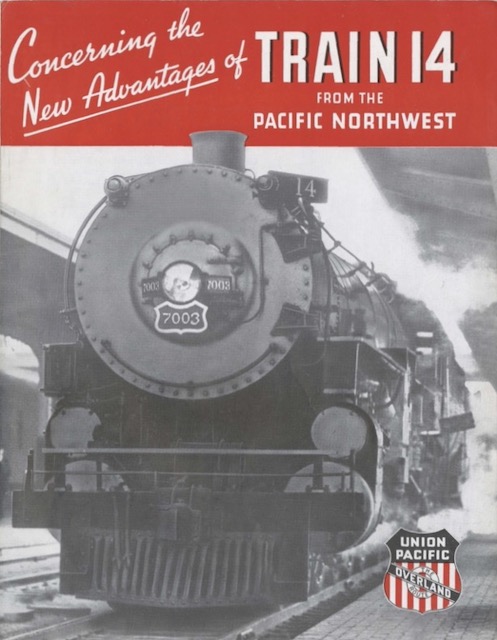This has to be one of the lamest railroad brochures I have ever seen. The passive opening headline, “Concerning the new advantages. . .,” absolutely would not inspire me to open it. Why is it about “train 14” and not the Pacific Limited, which is a much more attractive designation?
 Click image to download a 1.9-MB PDF of this brochure.
Click image to download a 1.9-MB PDF of this brochure.
Worse, before this brochure, the eastbound Pacific Limited was numbered 20, not 14. The number was changed to 14 on April 1, 1935. So by advertising “train 14” on the cover, UP was promoting a train number that northwesterners didn’t even identify with the Pacific Limited.
The “new advantages” of the train, according to the brochure, are that 11-1/2 hours had been cut from the Portland-Chicago schedule, which is a real advantage, and that it makes a “new, convenient departure from Portland.” The new departure time was 8:40 am, but according to this 1934 timetable, the previous departure time was 8:15 am. I suppose that’s a small advantage for anyone who wants to sleep in another 25 minutes.
The brochure hints that the Pacific Limited was a third-ranked train, after the City of Portland and Portland Rose. In fact, it was what would later be called a “city of everywhere” train, with sections from San Francisco and Los Angeles meeting in Salt Lake City, then meeting the Portland section in Green River, and then splitting up in Cheyenne with one section going to Chicago and the other to Kansas City, and St. Louis.
The train had coaches, tourist sleepers, and standard sleepers between Chicago and all three West Coast cities, and other coaches, tourist sleepers, and standard sleepers between Kansas City and all three West Coast cities. Add in the diner and club observation lounge car and the train must have had at least 20 cars, plus baggage cars, between Green River and Cheyenne. Considering all the shuffling that had to be done in Salt Lake, Green River, and Cheyenne, it seems like it might have been easier, and certainly faster, to just run separate trains.
